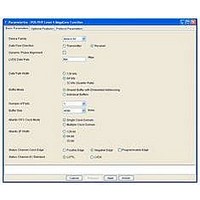IPR-POSPHY4 Altera, IPR-POSPHY4 Datasheet - Page 78

IPR-POSPHY4
Manufacturer Part Number
IPR-POSPHY4
Description
IP CORE Renewal Of IP-POSPHY4
Manufacturer
Altera
Type
MegaCorer
Specifications of IPR-POSPHY4
Software Application
IP CORE, Interface And Protocols, COMMUNICATION
Supported Families
Arria GX, Cyclone, HardCopy, Stratix
Core Architecture
FPGA
Core Sub-architecture
Arria, Cyclone, Stratix
Rohs Compliant
NA
Function
POS-PHY Level 4 Interface, Link-Layer/PHY Layer
License
Renewal License
Lead Free Status / RoHS Status
na
Lead Free Status / RoHS Status
na
- Current page: 78 of 144
- Download datasheet (3Mb)
5–6
POS-PHY Level 4 MegaCore Function User Guide
Status Processor
1
For 32-bit (quarter-rate) variations, an ALTDDIO megafunction serializes the tdclk,
tdat, and tctl lines.
The transmitter MegaCore function monitors and decodes the tstat status channel
from the receiver. It handles framing, checking for DIP-2 errors, and extracting status.
The status is provided to the transmit scheduler if present, and is always available to
the user logic. The clock edge on which the transmitter samples the status channel is
programmable.
The re-timed optimistic/pessimistic filtered status appears on the following signals:
■
■
■
These signals are synchronous with the positive edge of txsys_clk. The txsys_clk
must be faster than the status clock, tsclk.
Based on the received status channel, these signals are updated when the finite state
machine is not in disable state. It is up to the user logic to ensure these signals are
used when stat_ts_sync is asserted.
In the individual buffers mode, if these signals are not connected to the user logic, the
Quartus II software removes the status FIFO buffer (tx_stat_fifo_user).
Figure 5–2. Transmitter Timing Diagram
Note to
(1) val is negated when the internal status FIFO buffer empties.
Given a calendar slot number, the status processor determines which port's status
belongs in the slot according to the calendar that it stores. When Asymmetric Port
Support is turned off, the port number corresponds with the slot number (that is, slot
one is port one, and so on). When Asymmetric Port Support is turned on, a
programmable calendar is stored in memory, and the port corresponding to the slot is
looked up.
If the Asymmetric Port Support parameter is turned on, the Avalon
Mapped (Avalon-MM) registers must be programmed prior to releasing the rsfrm bit
(refer to
ctl_ty_extstat_val: asserted when the following two signals are valid
ctl_ty_extstat_adr: port
ctl_ty_extstat: status
Figure
Appendix E
stat_ty_extstat_adr
5–2:
stat_ty_extstat_val
stat_ty_extstat
txsys_clk
and the
2'b00 2'b00 2'b00 2'b00 2'b01 2'bxx 2'bxx 2'bxx 2'b01 2'b00 2'b10
8'd0
“Avalon-MM Interface Register Map” on page
8'd1
8'd2
8'd3
8'd4
8'dx
Chapter 5: Functional Description—Transmitter
8'dx
8'dx
8'd5
December 2010 Altera Corporation
8'd6
8'd7
®
Memory-
2'b10
8'd0
Block Description
5–24).
Related parts for IPR-POSPHY4
Image
Part Number
Description
Manufacturer
Datasheet
Request
R

Part Number:
Description:
IP NIOS II MEGACORE RENEW
Manufacturer:
Altera
Datasheet:

Part Number:
Description:
IP CORE Renewal Of IP-XAUIPCS
Manufacturer:
Altera
Datasheet:

Part Number:
Description:
IP CORE Renewal Of IP-10GETHERNET
Manufacturer:
Altera
Datasheet:

Part Number:
Description:
IP CORE Renewal Of IP-ASI
Manufacturer:
Altera
Datasheet:

Part Number:
Description:
IP CORE Renewal Of IP-CIC
Manufacturer:
Altera
Datasheet:

Part Number:
Description:
IP CORE Renewal Of IP-CRC
Manufacturer:
Altera
Datasheet:

Part Number:
Description:
IP CORE Renewal Of IP-ED8B10B
Manufacturer:
Altera
Datasheet:

Part Number:
Description:
CPLD, EP610 Family, ECMOS Process, 300 Gates, 16 Macro Cells, 16 Reg., 16 User I/Os, 5V Supply, 35 Speed Grade, 24DIP
Manufacturer:
Altera Corporation
Datasheet:

Part Number:
Description:
CPLD, EP610 Family, ECMOS Process, 300 Gates, 16 Macro Cells, 16 Reg., 16 User I/Os, 5V Supply, 15 Speed Grade, 24DIP
Manufacturer:
Altera Corporation
Datasheet:

Part Number:
Description:
Manufacturer:
Altera Corporation
Datasheet:










